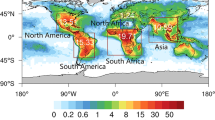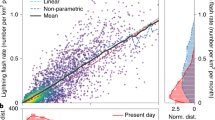Abstract
Lightning strongly influences atmospheric chemistry1,2,3, and impacts the frequency of natural wildfires4. Most previous studies project an increase in global lightning with climate change over the coming century1,5,6,7, but these typically use parameterizations of lightning that neglect cloud ice fluxes, a component generally considered to be fundamental to thunderstorm charging8. As such, the response of lightning to climate change is uncertain. Here, we compare lightning projections for 2100 using two parameterizations: the widely used cloud-top height (CTH) approach9, and a new upward cloud ice flux (IFLUX) approach10 that overcomes previous limitations. In contrast to the previously reported global increase in lightning based on CTH, we find a 15% decrease in total lightning flash rate with IFLUX in 2100 under a strong global warming scenario. Differences are largest in the tropics, where most lightning occurs, with implications for the estimation of future changes in tropospheric ozone and methane, as well as differences in their radiative forcings. These results suggest that lightning schemes more closely related to cloud ice and microphysical processes are needed to robustly estimate future changes in lightning and atmospheric composition.
This is a preview of subscription content, access via your institution
Access options
Access Nature and 54 other Nature Portfolio journals
Get Nature+, our best-value online-access subscription
$29.99 / 30 days
cancel any time
Subscribe to this journal
Receive 12 print issues and online access
$209.00 per year
only $17.42 per issue
Buy this article
- Purchase on Springer Link
- Instant access to full article PDF
Prices may be subject to local taxes which are calculated during checkout



Similar content being viewed by others
References
Schumann, U. & Huntrieser, H. The global lightning-induced nitrogen oxides source. Atmos. Chem. Phys. 7, 3823–3907 (2007).
Murray, L. T. Lightning NOx and impacts on air quality. Curr. Pollut. Rep. 2, 115–133 (2016).
Tost, H. Chemistry-climate interactions of aerosol nitrate from lightning. Atmos. Chem. Phys. 17, 1125–1142 (2017).
Krause, A., Kloster, S., Wilkenskjeld, S. & Paeth, H. The sensitivity of global wildfires to simulated past, present, and future lightning frequency. J. Geophys. Res. Biogeosci. 119, 312–322 (2014).
Price, C. & Rind, D. Possible implications of global climate change on global lightning distributions and frequencies. J. Geophys. Res. 99, 10823–10831 (1994).
Clark, S. K., Ward, D. S. & Mahowald, N. M. Parameterization-based uncertainty in future lightning flash density. Geophys. Res. Lett. 44, 2893–2901 (2017).
Banerjee, A. et al. Lightning NOx, a key chemistry–climate interaction: impacts of future climate change and consequences for tropospheric oxidising capacity. Atmos. Chem. Phys. 14, 9871–9881 (2014).
Reynolds, S. E., Brook, M. & Gourley, M. F. Thunderstorm charge separation. J. Meteorol. 14, 426–436 (1957).
Price, C. & Rind, D. A simple lightning parameterization for calculating global lightning distributions. J. Geophys. Res. 97, 9919–9933 (1992).
Finney, D. L. et al. Using cloud ice flux to parametrise large-scale lightning. Atmos. Chem. Phys. 14, 12665–12682 (2014).
Collins, M. et al. in Climate Change 2013: The Physical Science Basis (eds Stocker, T. F. et al.) (IPCC, Cambridge Univ. Press, 2013).
Latham, J., Petersen, W. A., Deierling, W. & Christian, H. J. Field identification of a unique globally dominant mechanism of thunderstorm electrification. Q. J. R. Meteorol. Soc. 133, 1453–1457 (2007).
Zeng, G., Pyle, J. A. & Young, P. J. Impact of climate change on tropospheric ozone and its global budgets. Atmos. Chem. Phys. 8, 369–387 (2008).
Jiang, H. & Liao, H. Projected changes in NOx emissions from lightning as a result of 2000-2050 climate change. Atmos. Ocean. Sci. Lett. 6, 284–289 (2013).
Williams, E. R. Lightning and climate: A review. Atmos. Res. 76, 272–287 (2005).
Price, C. G. Lightning applications in weather and climate research. Surv. Geophys. https://doi.org/10.1007/s10712-012-9218-7 (2013).
Allen, D. J. & Pickering, K. E. Evaluation of lightning flash rate parameterizations for use in a global chemical transport model. J. Geophys. Res. Atmos. 107, 15–21 (2002).
Finney, D.L., Doherty, R. M., Wild, O., Young, P. J. & Butler, A. Response of lightning NOx emissions andozone production to climate change: Insights from the Atmospheric Chemistry and Climate Model Intercomparison Project (ACCMIP). Geophys. Res. Lett 43, 5492–5500 (2016).
Tost, H., Jöckel, P. & Lelieveld, J. Lightning and convection parameterisations - uncertainties in global modelling. Atmos. Chem. Phys. 7, 4553–4568 (2007).
Jacobson, M. Z. & Streets, D. G. Influence of future anthropogenic emissions on climate, natural emissions, and air quality. J. Geophys. Res. 114, D08118 (2009).
Finney, D. L., Doherty, R. M., Wild, O. & Abraham, N. L. The impact of lightning on tropospheric ozone chemistry using a new global lightning parametrisation. Atmos. Chem. Phys. 16, 7507–7522 (2016).
van Vuuren, D. P. et al. The representative concentration pathways: An overview. Clim. Change 109, 5–31 (2011).
Romps, D. M., Seeley, J. T., Vollaro, D. & Molinari, J. Projected increase in lightning strikes in the United States due to global warming. Science 346, 851–854 (2014).
Satori, G., Williams, E. & Lemperger, I. Variability of global lightning activity on the ENSO time scale. Atmos. Res. 91, 500–507 (2009).
Bond, D. W., Steiger, S., Zhang, R., Tie, X. & Orville, R. E. The importance of NOx production by lightning in the tropics. Atmos. Environ. 36, 1509–1519 (2002).
Kang, S. M., Deser, C. & Polvani, L. M. Uncertainty in climate change projections of the Hadley circulation: The role of internal variability. J. Clim. 26, 7541–7554 (2013).
Jiang, J. H. et al. Evaluation of cloud and water vapor simulations in CMIP5 climate models using NASA ‘ATrain’ satellite observations. J. Geophys. Res. Atmos. https://doi.org/10.1029/2011JD017237 (2012).
Jacob, D. J., & Winner, D. A. Effect of climate change on air quality. Atmos. Environ. 43, 51–63 (2009).
Toumi, R., Haigh, J. D. & Law, K. S. A tropospheric ozone-lightning climate feedback. Geophys. Res. Lett. 23, 1037–1040 (1996).
Dahlmann, K., Grewe, V., Ponater, M. & Matthes, S. Quantifying the contributions of individual NOx sources to the trend in ozone radiative forcing. Atmos. Environ. 45, 2860–2868 (2011).
Liaskos, C. E., Allen, D. J. & Pickering, K. E. Sensitivity of tropical tropospheric composition to lightning NOx production as determined by the NASA GEOS-Replay model. J. Geophys. Res. Atmos. 120, 8512–8534 (2015).
Wild, O., Prather, M. J. & Akimoto, H. Indirect long-term global radiative cooling from NOx emissions. Geophys. Res. Lett. 28, 1719–1722 (2001).
Stevenson, D. S. et al. Tropospheric ozone changes, radiative forcing and attribution to emissions in the Atmospheric Chemistry and Climate Model Intercomparison Project (ACCMIP). Atmos. Chem. Phys. 13, 3063–3085 (2013).
Walters, D. N. et al. The Met Office Unified Model Global Atmosphere 4.0 and JULES Global Land 4.0 configurations. Geosci. Model Dev. 7, 361–386 (2014).
O’Connor, F. M. et al. Evaluation of the new UKCA climate-composition model – Part 2: The Troposphere. Geosci. Model Dev. 7, 41–91 (2014).
Wilson, D. R., Bushell, A. C., Kerr-Munslow, A. M., Price, J. D. & Morcrette, C. J. PC2: A prognostic cloud fraction and condensation scheme. I: Scheme description. Q. J. R. Meteorol. Soc. 134, 2093–2107 (2008).
Wilson, D. R. et al. PC2: A prognostic cloud fraction and condensation scheme. II: Climate model simulations. Q. J. R. Meteorol. Soc. 134, 2109–2125 (2008).
Morcrette, C. J. Improvements to a prognostic cloud scheme through changes to its cloud erosion parametrization. Atmos. Sci. Lett. 13, 95–102 (2012).
Waliser, D. E. et al. Cloud ice: A climate model challenge with signs and expectations of progress. J. Geophys. Res. 114, D00A21 (2009).
Li, J. L. F. et al. An observationally based evaluation of cloud ice water in CMIP3 and CMIP5 GCMs and contemporary reanalyses using contemporary satellite data. J. Geophys. Res. Atmos. https://doi.org/10.1029/2012JD017640 (2012).
Lamarque, J. F. et al. Historical (1850-2000) gridded anthropogenic and biomass burning emissions of reactive gases and aerosols: methodology and application. Atmos. Chem. Phys. 10, 7017–7039 (2010).
Reynolds, R. W. et al. Daily high-resolution-blended analyses for sea surface temperature. J. Clim. 20, 5473–5496 (2007).
Rossow, W. B., Walker, A. W., Beuschel, D. E. & Roiter, M. D. International Satellite Cloud ClimatologyProject (ISCCP) Documentation of New Cloud Datasets WMO/TD-No. 737 (World Meteorological Organization,1996).
Mansell, E. R., MacGorman, D. R., Ziegler, C. L. & Straka, J. M. Simulated three-dimensional branched lightning in a numerical thunderstorm model. J. Geophys. Res. Atmos. 107, ACL 2-1–ACL 2-12 (2002).
Barthe, C., Deierling, W. & Barth, M. C. Estimation of total lightning from various storm parameters: a cloud-resolving model study. J. Geophys. Res. 115, D24202 (2010).
Barthe, C., Chong, M., Pinty, J. P., Bovalo, C. & Escobar, J. CELLSv1.0: updated and parallelized version of an electrical scheme to simulate multiple electrified clouds and flashes over large domains. Geosci. Model Dev. 5, 167–184 (2012).
Fierro, A. O., Mansell, E. R., MacGorman, D. R. & Ziegler, C. L. The implementation of an explicit charging and discharge lightning scheme within the WRF-ARW model: benchmark simulations of a continental squall line, a tropical cyclone, and a winter storm. Mon. Weather Rev. 141, 2390–2415 (2013).
Basarab, B. M., Rutledge, S. A. & Fuchs, B. R. An improved lightning flash rate parameterization developed from Colorado DC3 thunderstorm data for use in cloud-resolving chemical transport models. J. Geophys. Res. 120, 9481–9499 (2015).
Hoerling, M. P., Schaack, T. K. & Lenzen, A. J. A global analysis of stratospheric–tropospheric exchange during northern winter. Mon. Weather Rev. 121, 162–172 (1993).
Ott, L. E. et al. Production of lightning NOx and its vertical distribution calculated from three-dimensional cloud-scale chemical transport model simulations. J. Geophys. Res. 115, D04301 (2010).
Cecil, D. J., Buechler, D. E. & Blakeslee, R. J. Gridded lightning climatology from TRMM-LIS and OTD: dataset description. Atmos. Res. 135–136, 404–414 (2014).
Prather, M. J. et al. in Climate Change 2001: The Scientific Basis (eds Houghton, J. T., Ding, Y. & Griggs, D. J.) (IPCC, Cambridge Univ. Press, 2001).
Voulgarakis, A. et al. Analysis of present day and future OH and methane lifetime in the ACCMIP simulations. Atmos. Chem. Phys. 12, 22945–23005 (2013).
Myhre, G., Highwood, E. J., Shine, K. P. & Stordal, F. New estimates of radiative forcing due to well mixed greenhouse gases. Geophys. Res. Lett. 25, 2715–2718 (1998).
Wild, O. et al. Modelling future changes in surface ozone: a parameterized approach. Atmos. Chem. Phys. 12, 2037–2054 (2012).
Acknowledgements
This work has been supported by a Natural Environment Research Council grant NE/K500835/1. We thank L. Abraham for his assistance with set-up and use of the UK Chemistry and Aerosols model, and L. Jackson for his advice regarding the calculation of significance.
Author information
Authors and Affiliations
Contributions
D.L.F., R.M.D. and O.W. designed the study and interpreted the results with input from other co-authors. O.W. and D.S.S. advised on the radiative forcing analysis. D.L.F. performed the analysis, developed the code and ran the simulations. D.L.F. prepared the manuscript with contributions from R.M.D. and O.W.; all co-authors reviewed the manuscript.
Corresponding author
Ethics declarations
Competing interests
The authors declare no competing financial interests.
Additional information
Publisher’s note: Springer Nature remains neutral with regard to jurisdictional claims in published maps and institutional affiliations.
Supplementary information
Supplementary Information
Supplementary Text, Supplementary References, Supplementary Tables 1–3, Supplementary Figures 1–3
Rights and permissions
About this article
Cite this article
Finney, D.L., Doherty, R.M., Wild, O. et al. A projected decrease in lightning under climate change. Nature Clim Change 8, 210–213 (2018). https://doi.org/10.1038/s41558-018-0072-6
Received:
Accepted:
Published:
Issue Date:
DOI: https://doi.org/10.1038/s41558-018-0072-6
This article is cited by
-
Significant increase in graupel and lightning occurrence in a warmer climate simulated by prognostic graupel parameterization
Scientific Reports (2024)
-
Optical observations of thunderstorms from the International Space Station: recent results and perspectives
npj Microgravity (2023)
-
Extratropical forests increasingly at risk due to lightning fires
Nature Geoscience (2023)
-
Variation of lightning-ignited wildfire patterns under climate change
Nature Communications (2023)
-
Amplification of annual and diurnal cycles of alpine lightning
Climate Dynamics (2023)



